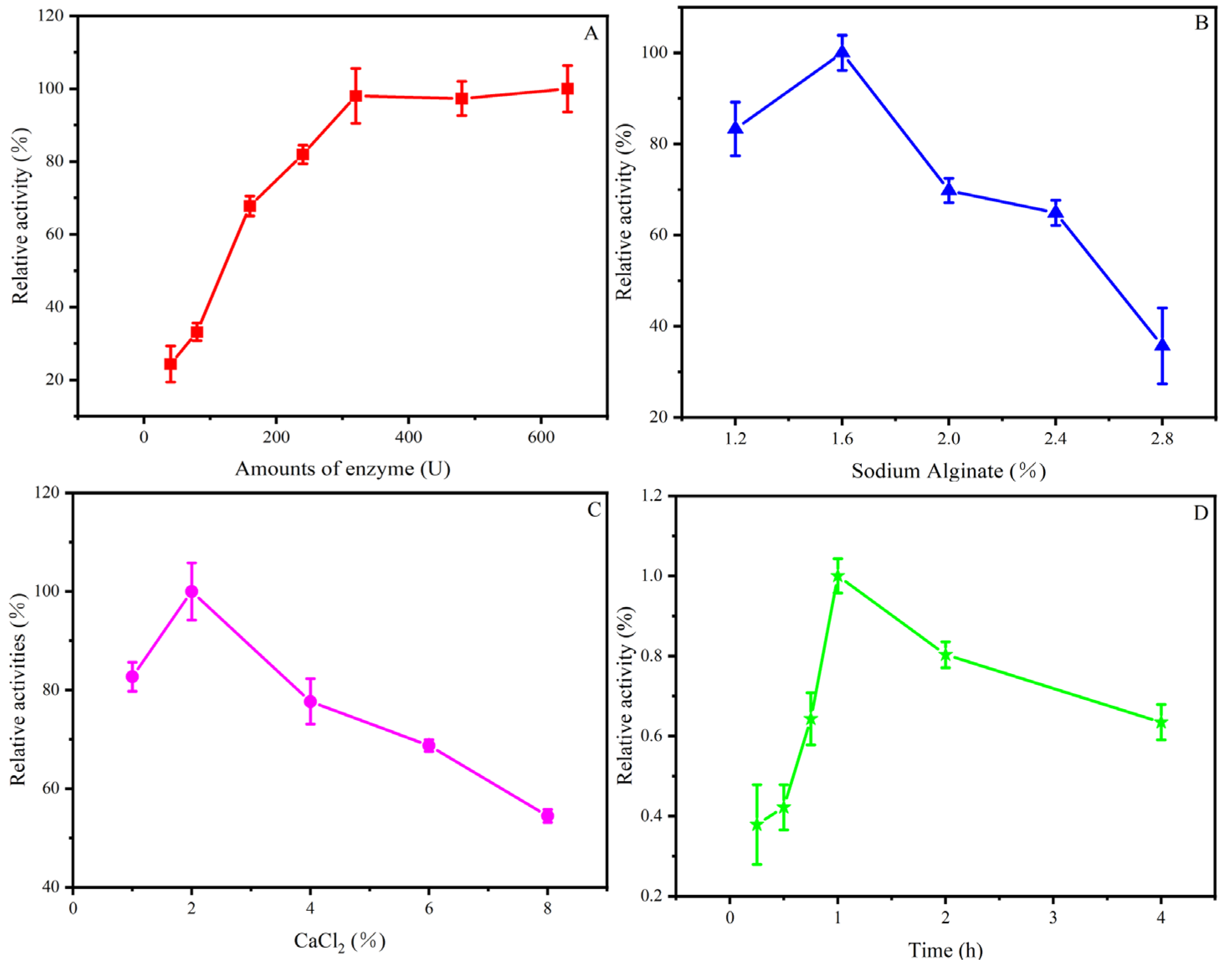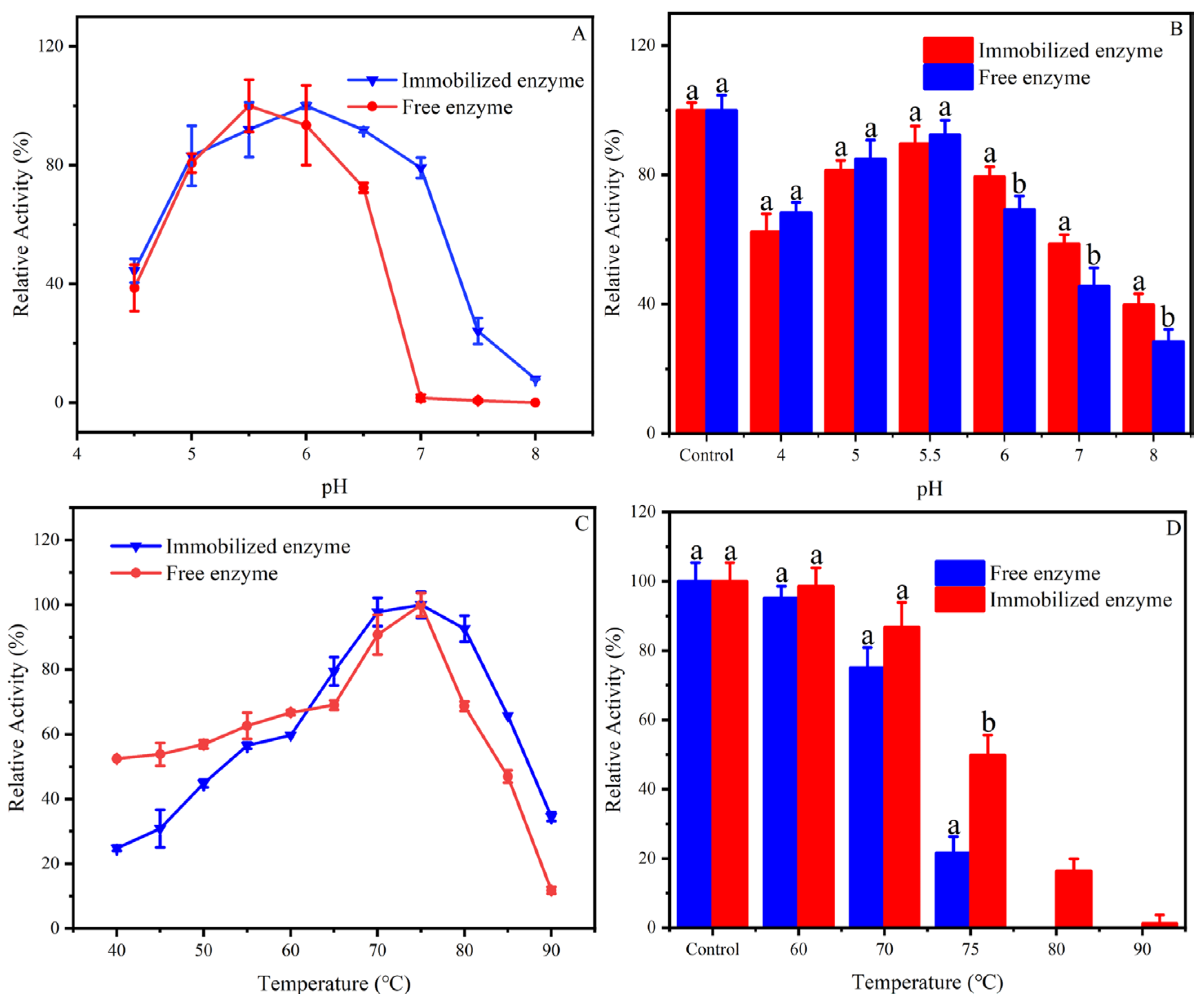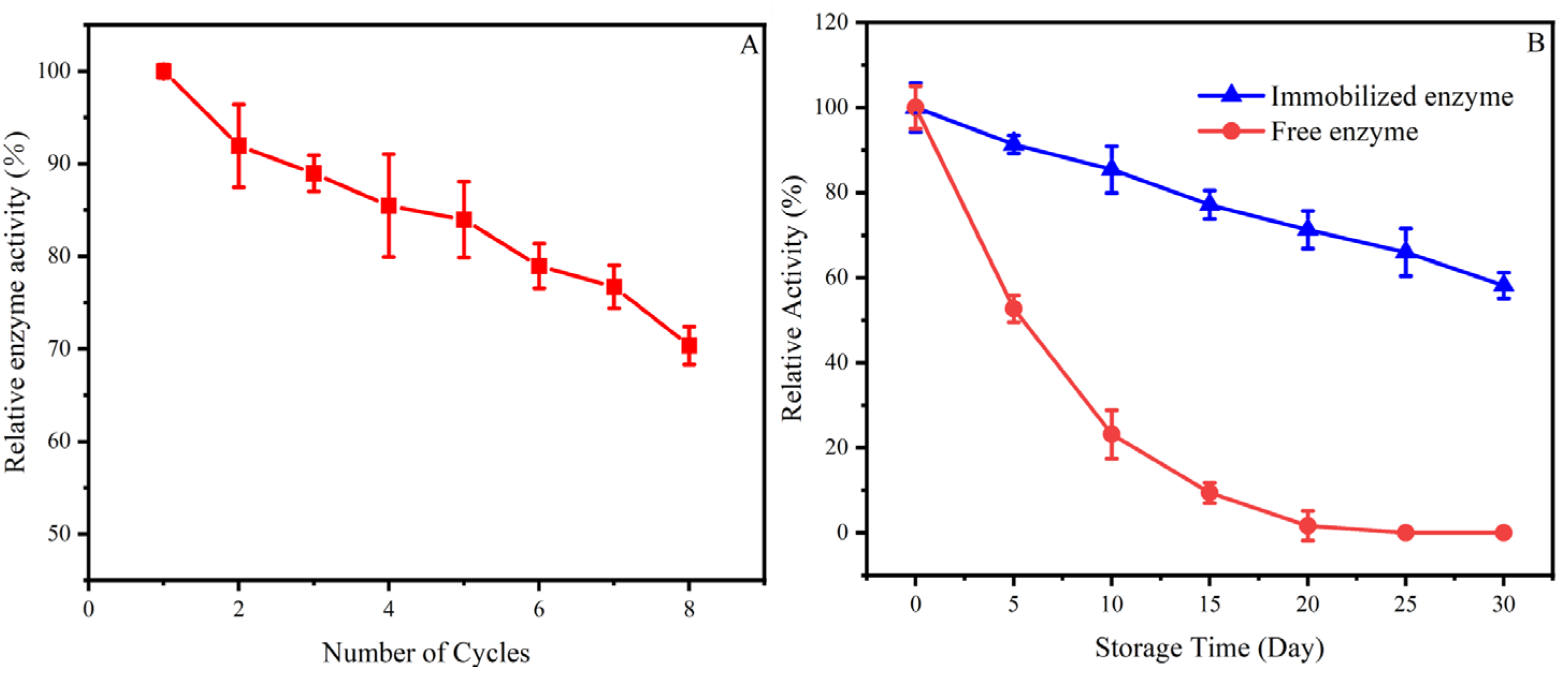Enhanced Enzymatic Performance of β-Mannanase Immobilized on Calcium Alginate Beads for the Generation of Mannan Oligosaccharides
Abstract
:1. Introduction
2. Materials and Methods
2.1. Raw Materials and Chemicals
2.2. Enzyme Assay
2.3. Effect of Immobilization Conditions on β-Mannanase
2.4. Effect of Temperature and pH of Man-CaAlg
2.5. Determination of Kinetic Parameters
2.6. Reusability and Storage Stability of Man-CaAlg
2.7. Enzymatic Hydrolysis of KGM
2.8. Statistical Analysis
3. Results and Discussion
3.1. Effect of Immobilization Conditions on Man-CaAlg
3.2. Effect of Temperature and pH on Man-CaAlg and Free β-Mannanase
3.3. Enzyme Kinetics of Man-CaAlg and Free β-Mannanase
3.4. Reusability and Storage Stability of Man-CaAlg
3.5. MOSs Generation
4. Conclusions
Author Contributions
Funding
Data Availability Statement
Acknowledgments
Conflicts of Interest
References
- Shah, B.R.; Li, B.; Wang, L.; Liu, S.; Li, Y.; Wei, X.; Jin, W.; Li, Z. Health benefits of konjac glucomannan with special focus on diabetes. Bioact. Carbohydr. Diet. Fibre 2015, 5, 179–187. [Google Scholar] [CrossRef]
- Mao, Y.H.; Song, A.X.; Yao, Z.P.; Wu, J.Y. Protective effects of natural and partially degraded konjac glucomannan on Bifidobacteria against antibiotic damage. Carbohydr. Polym. 2018, 181, 368–375. [Google Scholar] [CrossRef] [PubMed]
- Faustino, M.; Durão, J.; Pereira, C.F.; Pintado, M.E.; Carvalho, A.P. Mannans and mannan oligosaccharides (MOS) from Saccharomyces cerevisiae—A sustainable source of functional ingredients. Carbohydr. Polym. 2021, 272, 118467. [Google Scholar] [CrossRef]
- Zhao, W.; Chen, L.; Tan, W.; Li, Y.; Sun, L.; Zhu, X.; Wang, S.; Gao, P.; Zhu, C.; Shu, G.; et al. Mannan Oligosaccharides Promoted Skeletal Muscle Hypertrophy through the Gut Microbiome and Microbial Metabolites in Mice. Foods 2023, 12, 357. [Google Scholar] [CrossRef]
- Mano, M.C.R.; Neri-Numa, I.A.; da Silva, J.B.; Paulino, B.N.; Pessoa, M.G.; Pastore, G.M. Oligosaccharide biotechnology: An approach of prebiotic revolution on the industry. Appl. Microbiol. Biotechnol. 2018, 102, 17–37. [Google Scholar] [CrossRef]
- Singh, S.; Singh, G.; Arya, S.K. Mannans: An overview of properties and application in food products. Int. J. Biol. Macromol. 2018, 119, 79–95. [Google Scholar] [CrossRef] [PubMed]
- Xu, W.; Han, M.; Zhang, W.; Zhang, F.; Lei, F.; Wang, K.; Jiang, J. Production of manno-oligosaccharide from Gleditsia microphylla galactomannan using acetic acid and ferrous chloride. Food Chem. 2021, 346, 128844. [Google Scholar] [CrossRef]
- Jian, W.; Chen, Y.H.; Wang, L.; Tu, L.; Xiong, H.; Sun, Y.M. Preparation and cellular protection against oxidation of Konjac oligosaccharides obtained by combination of gamma-irradiation and enzymatic hydrolysis. Food Res. Int. 2018, 107, 93–101. [Google Scholar] [CrossRef]
- Kumar Suryawanshi, R.; Kango, N. Production of mannooligosaccharides from various mannans and evaluation of their prebiotic potential. Food Chem. 2021, 334, 127428. [Google Scholar] [CrossRef]
- Jana, U.K.; Kango, N. Characteristics and bioactive properties of mannooligosaccharides derived from agro-waste mannans. Int. J. Biol. Macromol. 2020, 149, 931–940. [Google Scholar] [CrossRef]
- Yang, J.K.; Chen, Q.C.; Zhou, B.; Wang, X.J.; Liu, S.Q. Manno-oligosaccharide preparation by the hydrolysis of konjac flour with a thermostable endo-mannanase from Talaromyces cellulolyticus. J. Appl. Microbiol. 2019, 127, 520–532. [Google Scholar] [CrossRef]
- Yang, H.; Shi, P.; Lu, H.; Wang, H.; Luo, H.; Huang, H.; Yang, P.; Yao, B. A thermophilic β-mannanase from Neosartorya fischeri P1 with broad pH stability and significant hydrolysis ability of various mannan polymers. Food Chem. 2015, 173, 283–289. [Google Scholar] [CrossRef]
- Tang, S.; Lin, F.; Zheng, J.; Zhou, H. Effect of gene dosage and incubation temperature on production of β-mannanase by recombinant Pichia pastoris. J. Cent. South Univ. 2019, 26, 184–195. [Google Scholar] [CrossRef]
- Zhou, H.; Zheng, J.; Wang, Y. One Kind of β-Mannanase and Its Encoding Gene, Production Strain and Application. CN Patent CN103255118B, 5 November 2014. [Google Scholar]
- Liu, J.; Xu, Q.; Zhang, J.; Zhou, X.; Lyu, F.; Zhao, P.; Ding, Y. Preparation, composition analysis and antioxidant activities of konjac oligo-glucomannan. Carbohydr. Polym. 2015, 130, 398–404. [Google Scholar] [CrossRef] [PubMed]
- Li, Y.X.; Liu, H.J.; Shi, Y.Q.; Yan, Q.J.; You, X.; Jiang, Z.Q. Preparation, characterization, and prebiotic activity of manno-oligosaccharides produced from cassia gum by a glycoside hydrolase family 134 beta-mannanase. Food Chem. 2020, 309, 10. [Google Scholar] [CrossRef] [PubMed]
- Shalaby, A.G.; Esawy, M.; Hussein, M. Comparative study between free and immobilized Penicillium chrysogenum mannanase: A local fungal isolate. J. Appl. Pharm. Sci. 2017, 7, 97–104. [Google Scholar] [CrossRef]
- Blibech, M.; Chaari, F.; Bhiri, F.; Dammak, I.; Ghorbel, R.E.; Chaabouni, S.E. Production of manno-oligosaccharides from locust bean gum using immobilized Penicillium occitanis mannanase. J. Mol. Catal. B Enzym. 2011, 73, 111–115. [Google Scholar] [CrossRef]
- Suryawanshi, R.K.; Jana, U.K.; Prajapati, B.P.; Kango, N. Immobilization of Aspergillus quadrilineatus RSNK-1 multi-enzymatic system for fruit juice treatment and mannooligosaccharide generation. Food Chem. 2019, 289, 95–102. [Google Scholar] [CrossRef]
- Milessi, T.S.S.; Kopp, W.; Rojas, M.J.; Manrich, A.; Baptista-Neto, A.; Tardioli, P.W.; Giordano, R.C.; Fernandez-Lafuente, R.; Guisan, J.M.; Giordano, R.L.C. Immobilization and stabilization of an endoxylanase from Bacillus subtilis (XynA) for xylooligosaccharides (XOs) production. Catal. Today 2016, 259, 130–139. [Google Scholar] [CrossRef]
- Shen, Y.; Niu, L.; Yu, Z.; Wang, M.; Shang, Z.; Yang, Y. Sodium alginate-grafted β-cyclodextrins as a matrix for immobilized Arthrobacter simplex for cortisone acetate biotransfromation. Appl. Surf. Sci. 2018, 444, 42–47. [Google Scholar] [CrossRef]
- Bradford, M.M. A rapid and sensitive method for the quantitation of microgram quantities of protein utilizing the principle of protein-dye binding. Anal. Biochem. 1976, 72, 248–254. [Google Scholar] [CrossRef] [PubMed]
- Miller, G.L. Use of Dinitrosalicylic Acid Reagent for Determination of Reducing Sugar. Anal. Chem. 1959, 31, 426–428. [Google Scholar] [CrossRef]
- Maijala, P.; Kango, N.; Szijarto, N.; Viikari, L. Characterization of hemicellulases from thermophilic fungi. Antonie van Leeuwenhoek 2012, 101, 905–917. [Google Scholar] [CrossRef] [PubMed]
- Singh, S.; Singh, G.; Khatri, M.; Kaur, A.; Arya, S.K. Thermo and alkali stable β-mannanase: Characterization and application for removal of food (mannans based) stain. Int. J. Biol. Macromol. 2019, 134, 536–546. [Google Scholar] [CrossRef]
- Kumar, L.; Nagar, S.; Mittal, A.; Garg, N.; Gupta, V.K. Immobilization of xylanase purified from Bacillus pumilus VLK-1 and its application in enrichment of orange and grape juices. J. Food Sci. Technol. 2014, 51, 1737–1749. [Google Scholar] [CrossRef] [PubMed]
- Kumar, S.; Dwevedi, A.; Kayastha, A.M. Immobilization of soybean (Glycine max) urease on alginate and chitosan beads showing improved stability: Analytical applications. J. Mol. Catal. B Enzym. 2009, 58, 138–145. [Google Scholar] [CrossRef]
- George, M.; Abraham, T.E. Polyionic hydrocolloids for the intestinal delivery of protein drugs: Alginate and chitosan—A review. J. Control. Release 2006, 114, 1–14. [Google Scholar] [CrossRef]
- Dhiman, S.; Srivastava, B.; Singh, G.; Khatri, M.; Arya, S.K. Immobilization of mannanase on sodium alginate-grafted-β-cyclodextrin: An easy and cost effective approach for the improvement of enzyme properties. Int. J. Biol. Macromol. 2020, 156, 1347–1358. [Google Scholar] [CrossRef]
- Bilal, M.; Iqbal, H.M.N.; Hu, H.B.; Wang, W.; Zhang, X.H. Enhanced bio-catalytic performance and dye degradation potential of chitosan-encapsulated horseradish peroxidase in a packed bed reactor system. Sci. Total Environ. 2017, 575, 1352–1360. [Google Scholar] [CrossRef]
- Bilal, M.; Rasheed, T.; Iqbal, H.M.N.; Hu, H.; Wang, W.; Zhang, X. Novel characteristics of horseradish peroxidase immobilized onto the polyvinyl alcohol-alginate beads and its methyl orange degradation potential. Int. J. Biol. Macromol. 2017, 105, 328–335. [Google Scholar] [CrossRef]
- Homaei, A. Immobilization of Penaeus merguiensis alkaline phosphatase on gold nanorods for heavy metal detection. Ecotoxicol. Environ. Saf. 2017, 136, 1–7. [Google Scholar] [CrossRef]
- Rehman, H.U.; Aman, A.; Nawaz, M.A.; Karim, A.; Ghani, M.; Baloch, A.H.; Qader, S.A.U. Immobilization of pectin depolymerising polygalacturonase using different polymers. Int. J. Biol. Macromol. 2016, 82, 127–133. [Google Scholar] [CrossRef] [PubMed]
- Jampala, P.; Preethi, M.; Ramanujam, S.; Harish, B.S.; Uppuluri, K.B.; Anbazhagan, V. Immobilization of levan-xylanase nanohybrid on an alginate bead improves xylanase stability at wide pH and temperature. Int. J. Biol. Macromol. 2017, 95, 843–849. [Google Scholar] [CrossRef] [PubMed]
- Landarani-Isfahani, A.; Taheri-Kafrani, A.; Amini, M.; Mirkhani, V.; Moghadam, M.; Soozanipour, A.; Razmjou, A. Xylanase Immobilized on Novel Multifunctional Hyperbranched Polyglycerol-Grafted Magnetic Nanoparticles: An Efficient and Robust Biocatalyst. Langmuir 2015, 31, 9219–9227. [Google Scholar] [CrossRef] [PubMed]
- Esawy, M.A.; Gamal, A.A.; Kamel, Z.; Ismail, A.-M.S.; Abdel-Fattah, A.F. Evaluation of free and immobilized Aspergillus niger NRC1ami pectinase applicable in industrial processes. Carbohydr. Polym. 2013, 92, 1463–1469. [Google Scholar] [CrossRef] [PubMed]
- Bibi, Z.; Shahid, F.; Ul Qader, S.A.; Aman, A. Agar–agar entrapment increases the stability of endo-β-1,4-xylanase for repeated biodegradation of xylan. Int. J. Biol. Macromol. 2015, 75, 121–127. [Google Scholar] [CrossRef]
- Martín, M.C.; López, O.V.; Ciolino, A.E.; Morata, V.I.; Villar, M.A.; Ninago, M.D. Immobilization of enological pectinase in calcium alginate hydrogels: A potential biocatalyst for winemaking. Biocatal. Agric. Biotechnol. 2019, 18, 101091. [Google Scholar] [CrossRef]
- Frota, E.G.; Sartor, K.B.; Biduski, B.; Margarites, A.C.F.; Colla, L.M.; Piccin, J.S. Co-immobilization of amylases in porous crosslinked gelatin matrices by different reticulations approaches. Int. J. Biol. Macromol. 2020, 165, 1002–1009. [Google Scholar] [CrossRef]
- Dai, X.Y.; Kong, L.M.; Wang, X.L.; Zhu, Q.; Chen, K.; Zhou, T. Preparation, characterization and catalytic behavior of pectinase covalently immobilized onto sodium alginate/graphene oxide composite beads. Food Chem. 2018, 253, 185–193. [Google Scholar] [CrossRef]
- Yang, C.-H.; Yen, C.-C.; Jheng, J.-J.; Wang, C.-Y.; Chen, S.-S.; Huang, P.-Y.; Huang, K.-S.; Shaw, J.-F. Immobilization of Brassica oleracea Chlorophyllase 1 (BoCLH1) and Candida rugosa Lipase (CRL) in Magnetic Alginate Beads: An Enzymatic Evaluation in the Corresponding Proteins. Molecules 2014, 19, 11800–11815. [Google Scholar] [CrossRef]
- Bayramoglu, G.; Doz, T.; Ozalp, V.C.; Arica, M.Y. Improvement stability and performance of invertase via immobilization on to silanized and polymer brush grafted magnetic nanoparticles. Food Chem. 2017, 221, 1442–1450. [Google Scholar] [CrossRef] [PubMed]






| Enzyme Form | Specific Activity (U/mg) | Immobilization Yield (%) |
|---|---|---|
| Free β-mannanase | 15.4 ± 2.2 | |
| Man-CaAlg | 22.5 ± 1.5 | 68.3% |
Disclaimer/Publisher’s Note: The statements, opinions and data contained in all publications are solely those of the individual author(s) and contributor(s) and not of MDPI and/or the editor(s). MDPI and/or the editor(s) disclaim responsibility for any injury to people or property resulting from any ideas, methods, instructions or products referred to in the content. |
© 2023 by the authors. Licensee MDPI, Basel, Switzerland. This article is an open access article distributed under the terms and conditions of the Creative Commons Attribution (CC BY) license (https://creativecommons.org/licenses/by/4.0/).
Share and Cite
Chen, X.; Tian, Z.; Zhou, H.; Zhou, G.; Cheng, H. Enhanced Enzymatic Performance of β-Mannanase Immobilized on Calcium Alginate Beads for the Generation of Mannan Oligosaccharides. Foods 2023, 12, 3089. https://doi.org/10.3390/foods12163089
Chen X, Tian Z, Zhou H, Zhou G, Cheng H. Enhanced Enzymatic Performance of β-Mannanase Immobilized on Calcium Alginate Beads for the Generation of Mannan Oligosaccharides. Foods. 2023; 12(16):3089. https://doi.org/10.3390/foods12163089
Chicago/Turabian StyleChen, Xinggang, Zhuang Tian, Hongbo Zhou, Guoying Zhou, and Haina Cheng. 2023. "Enhanced Enzymatic Performance of β-Mannanase Immobilized on Calcium Alginate Beads for the Generation of Mannan Oligosaccharides" Foods 12, no. 16: 3089. https://doi.org/10.3390/foods12163089





